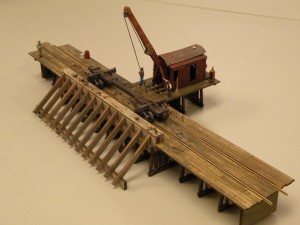Story and photos by Ken Liesse
On April 21st, about 30 folks were present when JJ Johnston opened the evening with words of welcome and recognition of our MMRs. A moment of silence was then held for 4D Superintendent Dennis Hill, who had unexpectedly passed away the previous week. We also had an update on the condition of Rev. Roger Ferris, who had suffered a stroke before last month’s meeting. Roger is resting at home and has almost full recovery of his extremities. If you’d like to leave Roger well wishes, you can write him at railfun@frontier.com. We hope Roger continues to have a speedy recovery.
JJ thanked all who donated door prizes (of which there were several) including Steve Depolo of Trains, Planes & Automobiles and Sue Van Gerpen of the Northwest Railway Museum. Sue donated a pair of tickets to ride the Snoqualmie Valley Railway. Ron Cole mentioned that the museum will be hosting “A Day Out with Thomas (the Tank Engine)” July 8-10 and 15-17. There will be an HO layout on hand for kids to run, and they are looking for people willing to help out with this project. If you are interested, contact Ron at 206-200-1059.
Thanks to a contact made by Sherm Stevens, we will probably have a field trip for our June meeting. Sherm contacted Mike O’Connell at Chooch Enterprises in Maple Valley, who agreed to host our group and show us his model railroad. JJ will be organizing carpools from our normal meeting place as parking at Mike’s is hard to come by. We expect a $5/person fee to help cover costs for drivers. Mike’s place is not handicap accessible. We’ll have more details on this excursion at the May meeting.
During the announcements portion of the clinic, Ken Liesse told the group that there are no current plans for a memorial to Dennis Hill. Dennis’ wife, Diana, would like to have a gathering at their house, but will wait for the weather to warm up a bit. Mark Anderson is again running the Issaquah Train Show in August. Details on the show will be forthcoming. Ted Becker is looking for anyone who would like to share a ride to Sacramento, CA for the NMRA convention, X2011West, in July. If you are planning on attending the convention and need a ride, contact Ted. Russ Segner brought in some photos from the Northwest Railway Museum showing the new track switch leading from the railway’s mainline to the new Train Shed as well as a 20′ solid oak beam that was being milled for use on the Chapel car.
There were several models (and other items) presented for Model of the Month including a “stinky” diorama, a couple of N scale GPs with a short train, a very old postcard depicting the San Francisco Bay Area, a scratchbuilt N scale milling machine, some scratchbuilt sloping tree stumps, a trestle and a brass N scale ditcher from Overland Models. JJ Johnston won with his kit built log dump, which is part of a BTS sawmill. JJ figured it was about time he brought something in that he had built himself.
Following the break, CJ Riley, MMR, presented a slide show titled “Layout Development on a Prototype Theme.” Using research and his own personal knowledge of West Virginia, CJ demonstrated how he was able to develop a location for his Kanawha & Western Allegheny Railroad and how anyone could use the same techniques to come up with an idea for their own railroad. CJ showed the difference between four different approaches to designing a model railroad: shotgun, prototype, freelance and proto-freelance. Shotgun is where the modeler just builds and runs whatever appeals to him/her at the time. Prototype is as the name implies; following a specific railroad and its practices. Freelance is where one makes up their own ideas, but is a little more focused than the shotgun approach. Proto-freelance is modeling your own railroad, but following applicable prototype practices and basing the railroad on actual locations.
CJ pointed to three words he uses when coming up with themes: Observation, Understanding, Selection. Observe the area in which you want to model, understand everything you can about the area (do your research) and select those items you really want to have on your layout. Use scenic markers for information on your area of interest and use authentic names that reflect the area you are modeling. Everyone enjoyed CJ’s presentation and the slides were quite interesting.
Next month, Russ Segner will be our clinician. His topic was not divulged, but you can bet it will worth seeing.


